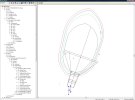JSF SAP mission planning computers means that JSF uses occasionally delivered DAFIF discs from NGA, uploaded into SAP JMPS and forgotten about. No RNAV capability, can load a few hundred points to the jet by referencing them in JMPS, or by using the world's greatest EFB (MAGTAB) to search and transcribe the lat/long.
USMC JSF doesn't allow any other EFB (restrictive SAP SOP), so we use contracted Samsung MAGTABs running AeroApp with data downloaded periodically from the NGA Aeronautical website and manually transferred to the Linux MAGTAB hub computer. Especially frustrating watching Navy JSF pulling out Foreflight in the same plane.
Interesting. I'm surprised the number of points is so low in a such a "new" AOP. Sounds like you don't ever mess with the points, but do they include the waypoint data, like runways or freqs?
Jeppesen has been contracted DoD wide to provide service validated DAFIF data through a packaging service that is fully integrated with JMPS according to the folks here - P-8 and E-2D were native launch platforms for Navy - presenter talked through other platforms that are being released this year and next. I did not hear V-22. But Boeing and Jepp basically got the big thumbs up over NGA it sounds like. Default will be Jepp data in All service aircraft with FMS.
I still don't know what that means. When they are saying "DAFIF data," is it just the waypoint data or is it additional graphical data that can be displayed (kind of like GMX-200 charts)? NGA DAFIF data is just waypoint data, the same you'd find in any GPS database, and it actually has a lot of information in it (basically the equivelent of the "Airport" tab in Foreflight).
This sounds a lot like when you purchase databases from Garmin and you have the two options: 1) Garmin for a lot of money or 2) Jeppsen for a lot of money plus $100. It's Jeppsen, so it's better! But in the end it's the same data. Where the Jepp data excels is the graphical representation of the FLIP stuff, assuming you have a system that can display it. I'm guessing the P-8 can display it, but a lot of the other fleet aircraft won't be able to (see the F-35 post above).

